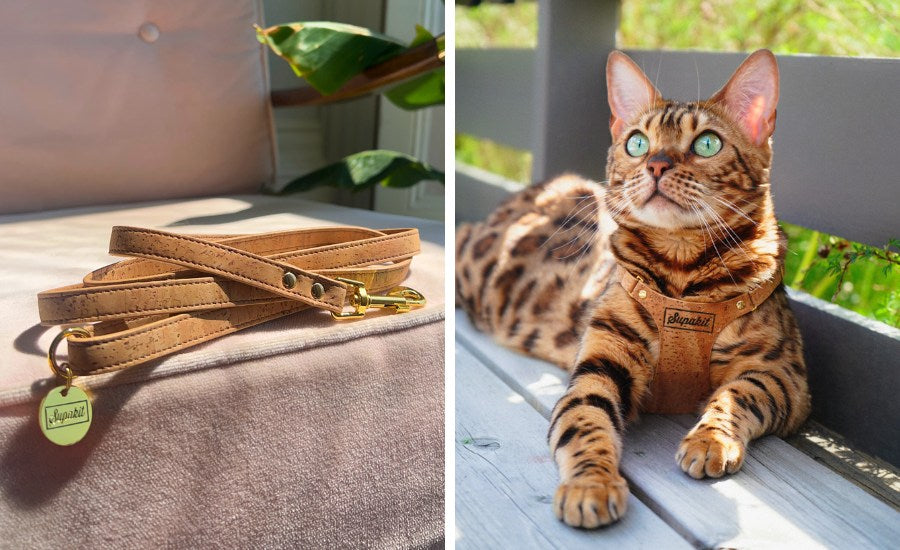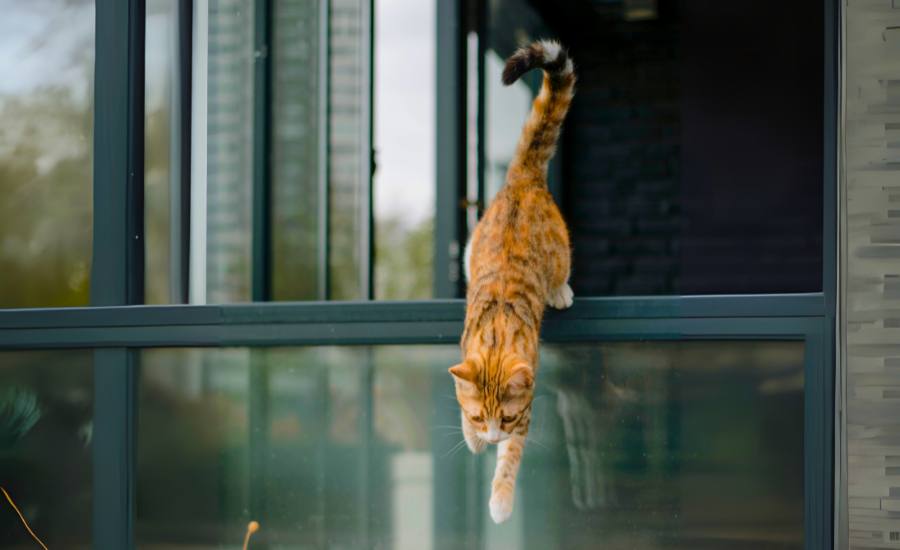How To Harness Train Your Cat - Supakit
Thinking of walking your indoor cat on a harness and leash, but not sure where to start? To celebrate the launch of the Supakit cat harness and leash, we’ve compiled the ultimate step-by-step guide to harness training your cat!
1. Choosing your cat's harness
You need to use a harness, rather than a collar when walking your cat outdoors. You want to find a harness that:
- Is nice and adjustable (or made to measure) so that you can achieve a snug and comfortable fit
- Has simple fastenings that you can do up quickly, and that won't spook your cat (e.g. steer clear of loud velcro if your cat hates loud noises)
- Has a strap or some form of fitting that sits behind your cat's elbows so that they can't escape by wriggling backwards out of their harness
- Is made of a comfortable and natural material like leather.
If you're purchasing a leash at the same time, look for a lightweight leash that is between 1 - 2 metres in length. Once your cat is fully harness trained you can introduce an extendable leash if you'd like, but during training a fixed one (or keeping your retractable one locked short) is better.
Related post: 'How To Fit Your Cat's Supakit Harness'
2. Introducing your cat to their harness - indoor training
Before you introduce your cat to their new harness, gather up some tasty food-based treats that you can use as a reward (you might like to whip up a batch of our homemade tuna cat treats!). If your cat just isn't that into food, you can switch up their rewards to whatever they enjoy - e.g. playtime with a favourite toy.
Once you've got your 'rewards' to hand, you're ready to begin!

Phase 1 - First encounters
At the first session, hold the harness out to your cat so that they can give it a good sniff. Whenever they show signs of taking a relaxed interest in the harness - e.g. inspecting it, sniffing it or rubbing their scent on it, reward them with a treat and praise.
How did it go?
-
My cat was super chilled when I showed them the harness
Great! You're ready for phase 2. -
My cat was pretty nervous around the harness
Don't worry! Keeping each session nice and short so that your cat always feels in control, repeat the training session above as many times as you need to (on different days) until your cat's anxiety levels around the harness drop. When they are happy and relaxed in the presence of the harness, you're ready for phase 2.
Phase 2 - Putting the harness on for the first time
Put the harness on your cat (without the leash), leave it a few seconds, and then remove it. Deploy treats and praise!
Over the next few sessions, start to build up the amount of time that you leave the harness on - taking your cues from your cat and what they are prepared to try. Each time your cat shows a little bravery or tolerates their harness for that little bit longer, reward them with their favourite treats and plenty of praise. Remember to go at your own pace, using positive reinforcement.
How did it go?
-
My cat lets me put the harness on but now they're just standing still / walking funny / hiding under some furniture!
This is a perfectly normal reaction as your cat gets used to the new sensations of wearing a harness. Don't panic! As long as they're able to wear their harness, you're ready to progress to Phase 3. -
My cat won't let me put their harness on without a battle
If your cat takes a strong dislike to their harness, take a few days off from training to give them a little bit of rest, before restarting your sessions again from the beginning of phase 2. See if you can break the process down into even smaller steps: e.g. pick your cat up and touch them with the harness (but don't put it on yet), deliver a reward, and so on. Once you've built up to the stage where they will put their harness on, you're ready for Phase 3!
Phase 3 - Walking in the harness

Over the next few sessions, encourage your cat to start to move in their harness, and give them lots of treats and praise for doing so to make it a positive experience. A feather toy can be handy to coax them into moving around, or you can place a treat one step in front of them, then two steps, and so on.
Continue this process until your cat is happy to walk in their harness, and their posture has relaxed from a low crouch to an upright, more natural walk.
Don't forget to still keep each training session nice and short. You want to make sure you stop before your cat's attention span expires!
How did it go?
-
My cat is moving around happily in their harness and walking pretty much normally
Wonderful! You're ready to progress to outdoor training. -
My cat is still moving unusually in their harness, or they don't seem to want to move at all
Don't worry - this is perfectly normal. Some cats can take longer than others to start to move naturally in their harness. Simply keep up the nice short training sessions (no more than one per day), keeping the progression between each one as gradual as possible.
Also, if your cat is quite a private cat, they may just be a little freaked out from all of the attention they are suddenly getting! In these cases, it can actually help to back off a little and give them some space to work out how they feel about the harness. Simply supervise them from a short distance away - you may find that they build in confidence on their own once they are a little less 'bombarded' with attention!
3. Outdoor training

For your cat's first trip outdoors, start small. You've taken baby steps to get your cat to this point, and you'll want to continue that strategy as you move outside. A stroll around your garden, or a quiet (preferably dog-free) park is the perfect starter-adventure.
What to expect
It’s worth taking a moment to talk about what ‘walking’ a cat looks like – because it doesn’t look much like a ‘walk’ at all! Instead of a journey from A to B, your cat’s outdoor exploration will likely be much more meandering. Let them set the pace and agenda, whilst you keep an eye out for any hazards. Slow, patient progress is the secret to becoming an adventure cat!
How to get there
Even if you are walking your cat just outside your house, it’s good practice to always transport them to the location you’ve chosen for your outdoor adventure, rather than letting them get there themselves. This will stop them from getting too independent, and thinking that they can go on solo adventures without you.
If you’re heading for your back yard, you can simply carry your cat in your arms, but if you’re venturing further afield, pop them in their cat carrier for the journey there and back.
What to pack
Don’t forget to pack a stash of treats to reward your cat as you go! You might also want to bring their cat carrier along, in case they get nervous and want to retreat to a place of safety. Finally, make sure your cat is wearing a breakaway cat collar and ID tag at all times (and ideally is microchipped too).
Leash training
Once your cat is outdoors, they will naturally start to test the boundaries of where they are allowed to go! If your cat wants to head in a direction that you’d rather they didn’t, all you need to do is gently, firmly, stand your ground. Hold the leash steady, give a calm verbal command (e.g. ‘no’) and make it clear to your cat that you’re not going to change your mind. Soon, your cat will realise that their chosen path just isn’t on the agenda, and they’ll find another direction to head off in.
Don’t forget to always make sure that your cat is safely under your control at all times. Because of this, we recommend that you don’t let your cat go climbing (e.g. up a tree or along a high fence), whilst on their harness and leash. If they do, there is a risk they could get tangled in their leash, or try to jump down without enough leash available to do so.
When to come home
For your cat’s first outdoor adventure, don’t expect the earth! They might not want to do any exploring at all, so remember that just being outside is a huge milestone and one to be proud of. You can build up from here, so keep the first sessions short and sweet, and stay tuned in to your cat’s personality and body language – you want them to come home happy and wanting more.
4. Building confidence

With each of your subsequent walks you can push your cat’s boundaries that little bit further, but remember to progress at your cat’s pace. It’s the gradual progression that’s key – don’t jump from a walk in the back yard to a canyon adventure without getting your cat used to all of the baby steps in between.
Remember too that sometimes your cat might just want to sit in their carrier and watch the world go by, and that’s OK!
Related posts: ‘Cat Walking, Your Questions Answered!’ and ‘Cat Exploring For Beginners With Hasara Lay From Catexplorer'
Do Cats Enjoy Walking?
Yes, cats enjoy walking if they are introduced to it the correct way. Like many things, walking is a skill they can learn, practice and hone over time. Embarking on a harness training journey with your cat, delivered at a slow and steady pace all whilst making it engaging and fun, will allow your cat to feel comfortable and confident, so they can enjoy walking. It’s important that your cat doesn’t feel stressed, as this can lead to issues, such as urinating outside of their litter box.
In a harness, your cat can play, nap, scratch, chase, and do all of the other things it enjoys doing.
Best Types of Harness for Cat Walking
The best type of harness for cat walking is one which allows your cat to move freely whilst keeping them safe and secure. There are several types of cat walking harnesses but most fall into the categories of vest, jacket, or H-style.
The Supakit harness is unique in that is does not fit neatly into any of these categories. Our innovative design combines the best elements of several harness styles, which allowed us to create a harness that is sleek, comfortable and extra secure for your cat.
Related: Best Escape-Proof Cat Harnesses
How Long Does It Take to Harness Train a Cat?
How long it takes to harness train your cat will depend on your cat. Your cat will have its own learning style and motivations. It is important not to compare your cat to others and let them set the pace of their training journey. A slow and steady approach with consistency usually provides the best results. Enjoy the process and the bonding time it provides for you and your cat.
Which Cat Breeds Cat Be Leash Trained?
Any cat breed can be leash trained; however, some breeds may be better suited due to their overall nature. For example, Bengal cats are known for their high intelligence, playfulness, and high-energy levels. Ragdolls comparatively are more placid and gentle, loving human company and affection. Ultimately, it will depend on the personality of your cat.
What Should You Do If You Encounter a Dog?
If you encounter a dog, you should put your cat somewhere they can feel safe and out of harms way. Some cats and dogs are happy to meet one another – it will depend on your cat and their experience with dogs, the dog’s experience with cats and whether the dog is leashed or not.
Best practice is to do ‘safe space’ training with your cat so when you do meet a dog, you can lift your cat and either hold them, put them into their ‘safe space’ (cat backpack or carrier) or let them perch somewhere high like your shoulder.
Can You Harness Train a Cat in Winter?
Yes, you can train your cat in winter and any other time of year. If your training is outdoors, you should consider whether or not is it conducive to training and safe for your cat. If the weather is stormy, windy or very cold, you may want to consider training indoors instead where your cat will be more comfortable.
Do People Judge You for Walking Your Cat?
For years, people have been walking their cats (search ‘Carey Grant walking his cat’ for a dreamy Hollywood throwback). If walking your cat is in their best interests and they love doing it, then don’t worry about people judging you or not. There are many benefits to walking your cat including sensory stimulation, environmental enrichment, and exercise.
Can You Train Your Cat Without a Leash?
Yes, you can train your cat without a leash, but you may want to consider whether or not it is safe to practice it. Walking your cat on a leash provides you with extra security, as you can guide them to walk on a safe path and keep them close to you. It also adds a layer of protection for the local wildlife.
Is It Too Late to Harness Train My Cat?
It is never too late to harness train your cat. Although it is generally easier to introduce new things to your cat when they are younger, older cats can learn to love harness training too. Work out what motivates your cat, how best to encourage them and work to a training schedule that caters to them. If your cat is a senior kitty, you may want to check with your vet before you embark on a harness training journey.
Related:







